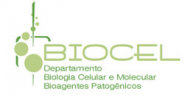Líder(es): Maria Celia Jamur
Telefone (s): (16) 3315-3217; (16) 3315-3143
Linha de pesquisa
Biologia de Células Secretoras e Tráfego Intracelular
Linhas gerais/General outline
Estudo do processo de recrutamento e migração de precursores de mastócitos, mastócitos imaturos e maduros utilizando diferentes modelos in vitro e in vivo.
Study of the recruitment and migration of mast cell precursors and immature and mature mast cells by different in vitro and in vivo models
Linhas de pesquisa/Research areas
Estudos recentes realizados em nosso laboratório identificaram o precursor comprometido com a linhagem de mastócitos e uma população de mastócitos em maturação, presentes na medula óssea de rato e camundongo. Os estudos atuais buscam entender os mecanismos que induzem a migração destas células da medula óssea para sítios periféricos durante o recrutamento, processo semelhante ao que ocorre durante a inflamação e a alergia. Estudos in vivo e in vitro são realizados utilizando marcadores específicos para estas duas populações, associados aos modelos experimentais que visam recrutar mastócitos para tecidos periféricos. O endereçamento de precursores de mastócitos e de mastócitos em maturação para os diferentes órgãos, está sendo estudado, após o seu isolamento, marcação e reintrodução em animais. Moléculas envolvidas na proliferação, migração e adesão de mastócitos também são analisadas, utilizando a linhagem de mastócitos RBL-2H3 e linhagens mutantes, bem como animais nocautes.
Recent studies carried out in our laboratory have identified the committed precursor for the mast cell lineage and a mast cell population in the maturation phase, in the bone marrow of rats and mice. Our ongoing studies aim to understand the mechanisms that induce migration of these cells from the bone marrow to peripheral sites during recruitment, a process similar to inflammation and allergy. In vivo and in vitro studies are performed by employing specific markers for these two populations, associated with experimental models, aiming at mast cell recruitment to peripheral tissues. The pathway followed by mast cell precursors and mast cells undergoing maturation to the various organs is being investigated after their isolation, targeting, and reintroduction into animals. Molecules involved in mast cell proliferation, migration, and adhesion are also analyzed using RBL-2H3 mast cell lineage and mutant lineages, as well as knockout animals.
Sugestões de leitura/Suggestions for further reading
Souza, A. M. M. S., Orlandini-Castro, R., Matioli, F., Siraganian, R. P., Jamur, M. C., Oliver, C. The α- galactosyl derivatives of ganglioside GD1b are essencial for FcεRI-mediated degranulation in RBL-2H3 mast cells. Experimental Cell Res., 314: 2515-2528, 2008
Guiraldelli, MG, Siraganian, RP, Berenstein, E, Grodzki, ACG, Jamur, MC, Oliver, C. The low affinity IgG receptor FcγRIIB contributes to the binding of a mast cell specific antibody mAb BGD6. Mol. Immunol., 45: 2411-2418, 2008
Oliver, C., Fujimura, A, Souza, A. M. M. S., Orlandini-Castro, R., Siraganian, R. P., Jamur, M. C.Mast cell specific gangliosides and FcepsilonRI fallow the same endocytic pathway from lipid rafts in RBL-2H3. J. Histochem. Cytochem, , 55: 315-324, 2007
Jamur, M.C., Grodzki, A.C.G., Berenstein, E.H., Hamawy, M.M., Siraganian, R.P. and Oliver, C. Identification and characterization of undifferentiated mast cells in mouse bone marrow. Blood, 105: 4282-4289, 2005
Jamur, M. C. Mastócitos. In: Células. Uma abordagem Multidisciplinar. Ed. Hernandes F. Carvalho & Carla B. Colares-Buzato. Manole, São Paulo, 2005, p. 382-391
